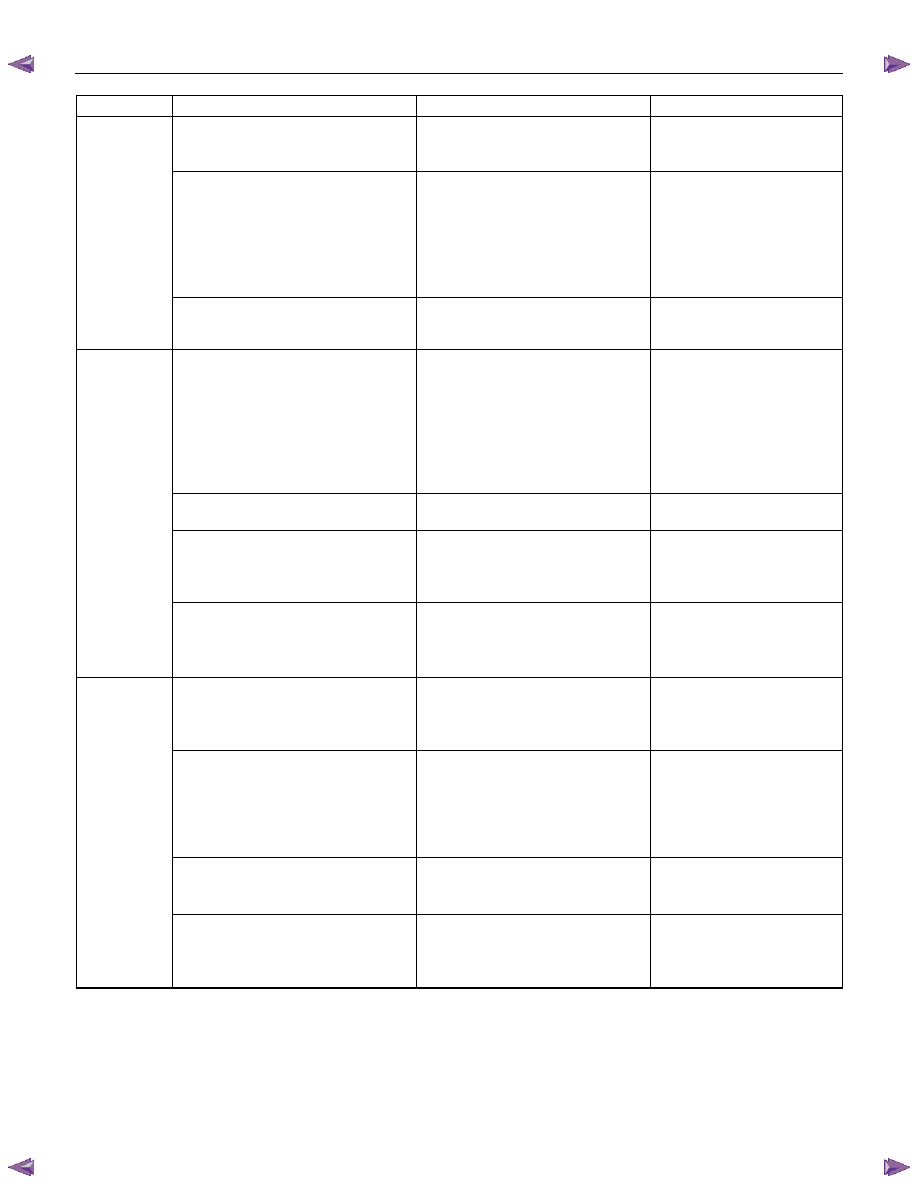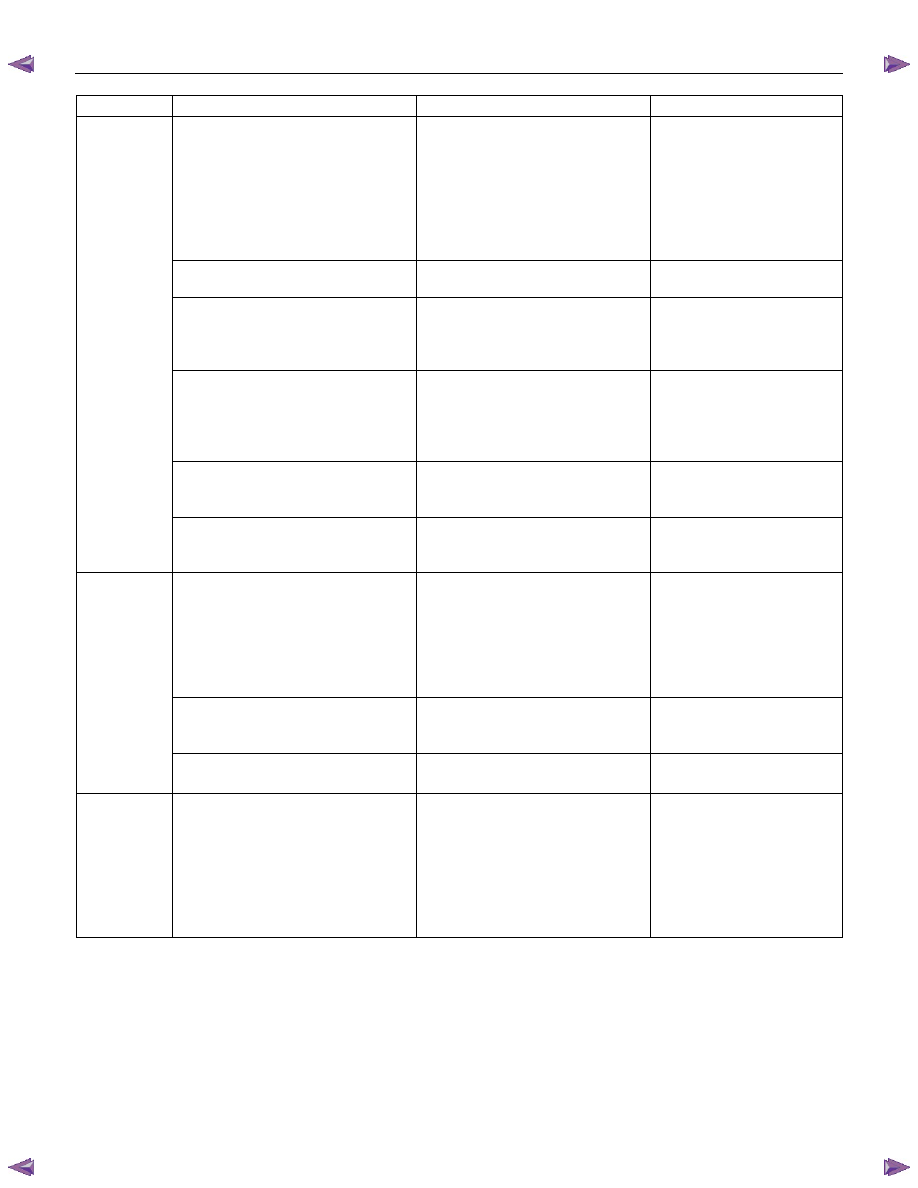Isuzu KB P190. Manual — part 31

1-90 HEATER AND AIR CONDITIONING
f06r300014
CHECKING REFRIGERANT SYSTEM
WITH MANIFOLD GAUGE
Conditions;
•
Ambient temperature at approx. 30
∼35°C (86∼95°F)
•
Run the engine at Idling
•
A/C switch is “ON”
•
Run the blower motor at “4” (high) position
•
Temperature control knob sets at “MAX COLD”
•
Air source selector lever at “CIRC”
•
Close the all doors
Normal pressures kPa (kg/cm
2
/psi);
Low-pressure side:
Approx. 127 – 245 (1.3 – 2.5 / 18 – 36)
High-pressure side:
Approx. 1373 – 1670 (14 – 17 / 199 – 242)
Connect the manifold gauge
Low-pressure hose (LOW)
∼ Suction side
High-pressure hose (HI)
∼ Discharge side

HEATER AND AIR CONDITIONING 1-91
RESULT
SYMPTOM
TROUBLE CAUSE
CORRECTION
Reduced or no air flow through
the condenser
•
Condenser clogged or dirty
•
Radiator (condenser) fan
does not operate properly
•
Clean
•
Check cooling fan
operation
No bubbles in sight glass when
condenser is cooled by water
(Insufficient cooling)
•
Excessive refrigerant in
system
•
Check sight glass.
(See “Reading Sight
Glass”)
•
Discharge and
recover refrigerant.
Recharge to specified
amount
Discharge
(High)
pressure
gauge
abnormally
high
After stopping air conditioning,
pressure drops approx. 196 kPa
(2.0kg/cm
2
/ 28psi) quickly
•
Air in system
•
Evacuate and charge
refrigerant system
Insufficient cooling and excessive
bubbles in the sight glass
•
Insufficient refrigerant in
system
•
Check sight glass.
(See “Reading Sight
Glass”)
•
Check for leaks
•
Discharge and
recover refrigerant.
Recharge to specified
amount
Low pressure gauge indicates
vacuum
•
Clogged or defective
expansion valve
•
Replace the
expansion valve
Frost or dew on refrigerant line
before and after receiver/ drier or
expansion valve, and low pres-
sure gauge indicates vacuum
•
Restriction caused by debris
or moisture in receiver/drier
•
Check system for
restriction and
replace receiver/drier
Discharge
(High)
pressure
gauge
abnormally
low
After turning off air conditioning,
high and low pressure gauge
balanced quickly
•
Compressor seal defective
•
Poor compression due to
defective compressor
gasket
•
Replace or repair
compressor
Low pressure gauge is lowered
after condenser is cooled by
water
•
Excessive refrigerant in
system
•
Discharge and
recover refrigerant
Recharge to specified
amount
Low pressure hose temperature
around the compressor refrigerant
line connector is lower than
around evaporator
•
Unsatisfactory valve
operation due to defective
temperature sensor of
expansion valve
•
Expansion valve opens too
long
•
Replace the
expansion valve
After turning off air conditioning,
high and low pressure gauge is
balanced quickly
•
Compressor gasket is
defective
•
Replace
Suction
(Low)
pressure
gauge
abnormally
high
Air conditioning turns off before
passenger compartment is
sufficiently
cool
•
Electronic thermostat
defective
•
Check the electronic
thermostat and
replace as necessary
* For the charging and discharging operations in the table above, refer to “RECOVERY, RECYCLING,
EVACUATION AND CHARGING” in this section.

1-92 HEATER AND AIR CONDITIONING
RESULT
SYMPTOM
TROUBLE CAUSE
CORRECTION
Condenser is not hot and
excessive bubble in sight glass
•
Insufficient refrigerant
•
Check sight
glass.(See “Reading
Sight Glass”)
•
Check for leaks
•
Discharge and
recover refrigerant.
Recharge to specified
amount
Frost on the expansion valve inlet
line
•
Expansion valve clogged
•
Replace the
expansion valve
A distinct difference in
temperature between the inlet and
outlet refrigerant lines of the
receiver/drier
•
Receiver/drier clogged
•
Replace the receiver/
drier
Expansion valve outlet refrigerant
line is not cold and low-pressure
gauge indicates vacuum
•
The temperature sensor of
the expansion valve is
defective, and the valve
cannot regulate the correct
flow of the refrigerant
•
Replace the
expansion valve
Discharge temperature is low and
air flow from vents is restricted
•
Frozen evaporator core fins
•
Check electronic
thermostat and
replace as necessary
Suction
(Low)
pressure
abnormally
low
Low-pressure gauge reading is
low, or a vacuum reading may be
shown
•
Clogged or blocked
refrigerant line
•
Replace refrigerant
line
No bubbles in sight glass after
condenser is cooled by water
(Insufficient cooling)
•
Excessive refrigerant in
system
•
Check sight
glass.(See “Reading
Sight Glass”)
•
Discharge and
recover refrigerant.
Recharge to specified
amount
Reduce air flow through con-
denser
•
Condenser clogged
•
Radiator (condenser) fan
does not rotate properly
•
Clean
•
Check cooling fan
operation
Suction
(Low) and
Discharge
(High)
pressure
abnor-
mally
high
Suction (Low) pressure hose is
not cold
•
Air in system
•
Evacuate and charge
refrigerant
Suction
(Low) and
Discharge
(High)
pres-sure
abnor-
mally
low
Insufficient cooling and excessive
bubbles in the sight glass
•
Insufficient refrigerant in
system
•
Check sight glass.
(See “Reading Sight
Glass”)
•
Check for leaks
•
Discharge and
recover refrigerant.
Recharge to specified
amount
HEATER AND AIR CONDITIONING 1-93
MAGNETIC CLUTCH
When the A/C switch and the fan control knob (fan switch) are turned on with the engine running, current flows
through the thermostat and the compressor relay to activate the magnetic clutch.
The air conditioning can be stopped by turning off the A/C switch or the fan control knob (fan switch).
However, even when the air conditioning is in operation, the electronic thermostat, the pressure switch or the ECM
is used to stop the air conditioning temporarily by turning off the magnetic clutch in the prearranged conditions to
reduce the engine load which is being caused by the rise in the engine coolant temperature, and the acceleration of
the vehicle, etc.

Нет комментариевНе стесняйтесь поделиться с нами вашим ценным мнением.
Текст